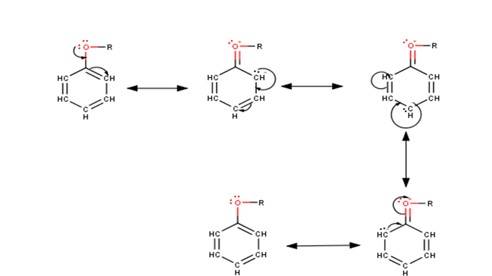Alcohol Phenol And Ethers
Get insights from 261 questions on Alcohol Phenol And Ethers, answered by students, alumni, and experts. You may also ask and answer any question you like about Alcohol Phenol And Ethers
Follow Ask QuestionQuestions
Discussions
Active Users
Followers
New answer posted
6 months agoContributor-Level 10
11.43
The driving force of all the reactions given to the question is that the alkoxy group is an ortho and para directing group because it exerts its +R effect in the benzene ring. Para position being comparatively more stable than the ortho position is usually preferred because ortho position leads to stearic hindrance, hence the major product is mostly the para- substituted compound.

As seen from the resonating structures above the structure in which the negative charge is in the para position will form a more stable product when attacked by an electrophile. Hence in the following reactions, we will be considering that resonating str
New answer posted
6 months agoContributor-Level 10
11.42
The reaction of HI with methoxymethane yields two different sets of products depending upon the initial amount of HI taken.
(i) When equal moles of HI and methoxymethane are taken, a mixture of methyl alcohol and methyl iodide is
The mechanism is given below:
In the first step, methoxymethane reacts with hydrogen iodide to extract a proton to give the dimethyloxonium ion.
In the second step of the reaction, the Dimethyloxonium ion reacts with the iodide ion present to yield methyl iodide and methyl alcohol as the product via SN2 pathway.
(ii) If an excess of HI is used the methyl alcohol formed in Step II is also convert
New answer posted
6 months agoContributor-Level 10
11.41
(i) In aryl alkyl ethers the +R effect of the alkoxy group leads to an increase in the electron density of the benzene ring as they push electrons into the ring making the benzene ring activated towards electrophilic substitution reactions. This could be understood more clearly from the following resonating structures : -
(ii) It could be clearly seen from the above resonating structures that the electron density increases more at the ortho and para positions as compared to the meta positions. Hence, we can conclude that the alkoxy group directs the incoming substituents to ortho and para positions in the benzene ring.
For e
New answer posted
6 months agoContributor-Level 10
11.40
1-Propoxypropane reacts with hydrogen iodide to give propan-1-ol and 1-iodopropane as the products.
2. Methoxybenzene reacts with hydrogen iodide to give phenol and iodomethane.
3. Benzyl ethyl ether reacts with hydrogen iodide to give benzyl iodide and ethanol.
New answer posted
6 months agoContributor-Level 10
11.39
The preparation of ether by acid dehydration of primary alcohol involves the nucleophilic addition of alcohol molecule to the protonated alcohol molecule as shown below: -
However, under these conditions secondary and tertiary alcohols forms alkenes rather than ethers. The reason for this being that due to stearic hindrance, nucleophilic attack by the alcohol molecule on the protonated alcohol molecule does not take place. Instead protonated 20 and 30 alcohols lose a molecule of water to form stable carbocations. The stable carbocations so formed prefers to lose a proton to form alkenes instead of forming ethers by undergoing
New answer posted
6 months agoContributor-Level 10
11.38
According to the question we have to perform the following conversion: -
The above conversion can be done easily by dehydrating 1- propanol with conc.H2SO4 at 413 K.
The mechanism of the above reaction is as follows : -
The mechanism is given below: -
In the first step, the alcohol gets protonated by the acid present to give a protonated alcohol.
In the second step, the nucleophilic attack of another alcohol molecule on the protonated alcohol gives us 1-propoxypropane as the desired product.
New answer posted
6 months agoContributor-Level 10
11.37
Williamson synthesis is basically a SN2 reaction of a primary alkyl halide with an alkoxide ion. The basic mechanism for this reaction is
Now consider this reaction,
This reaction proceeds as conventional Williamson synthesis. But if secondary or tertiary alkyl halides are taken in place of primary alkyl halides, then elimination would compete over substitution reaction, which will result in the formation of alkenes. The reason is alkoxides are better nucleophiles as well as strong bases. Therefore, they react with alkyl halides resulting in an elimination reaction.
New answer posted
6 months agoContributor-Level 10
11.36
During the reaction, an alkoxide ion is formed which is then added to an alkyl halide to form the ether via SN2 mechanism.
In the primary step, the nucleophile is formed (O- ) which will the approach to the alkyl halide and after the transition stage, the substitution takes place.
During the reaction, an alkoxide ion is formed which is then added to an alkyl halide to form the ether via SN2 mechanism.
During the reaction, an alkoxide ion is formed which is then added to an alkyl halide to form the ether via SN2 mechanism.
During the reaction, an alkoxide ion is formed which is then added to an alkyl halide to form the ether via
New answer posted
6 months agoContributor-Level 10
11.35
1-Ethoxy-2-methylpropane
2-Chloro-1-methoxyethane
4-Nitroanisole
1-Methoxypropane
1-Ethoxy-4,4-dimethylcyclohexane
Ethoxy benzene.
New answer posted
6 months agoContributor-Level 10
11.34
Due to the presence of -OH group, ethanol undergoes intermolecular hydrogen bonding which results in the association of molecules.
Therefore, extra energy is required to break those hydrogen bonds. Whereas methoxymethane does not undergo those hydrogen bonding which implies ethanol has a higher boiling point than that of methoxymethane.
Taking an Exam? Selecting a College?
Get authentic answers from experts, students and alumni that you won't find anywhere else
Sign Up on ShikshaOn Shiksha, get access to
- 65k Colleges
- 1.2k Exams
- 679k Reviews
- 1800k Answers
